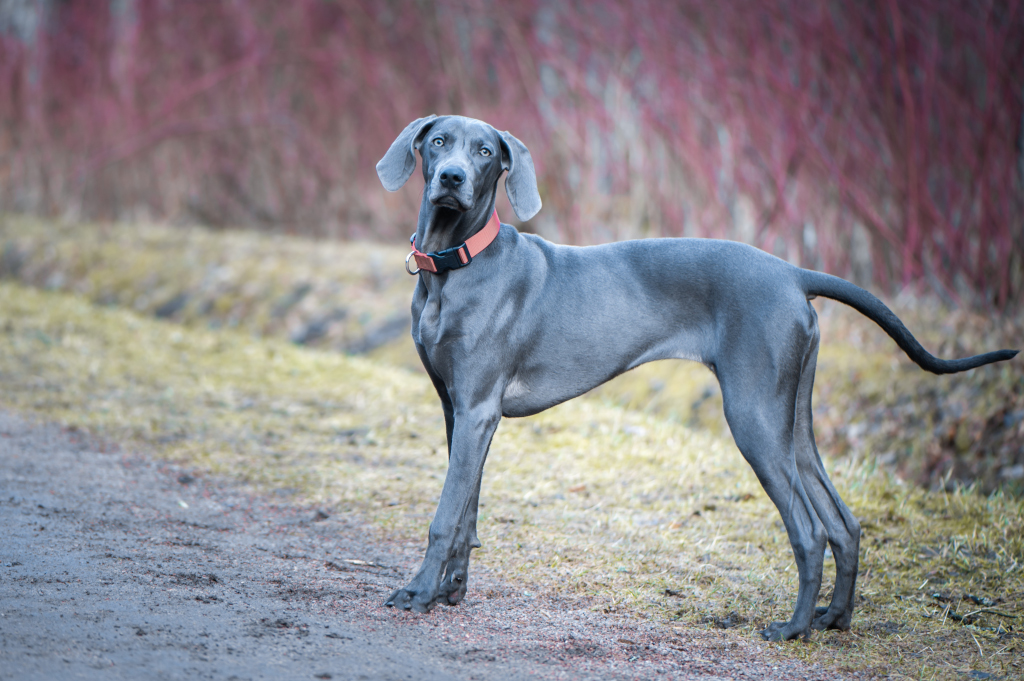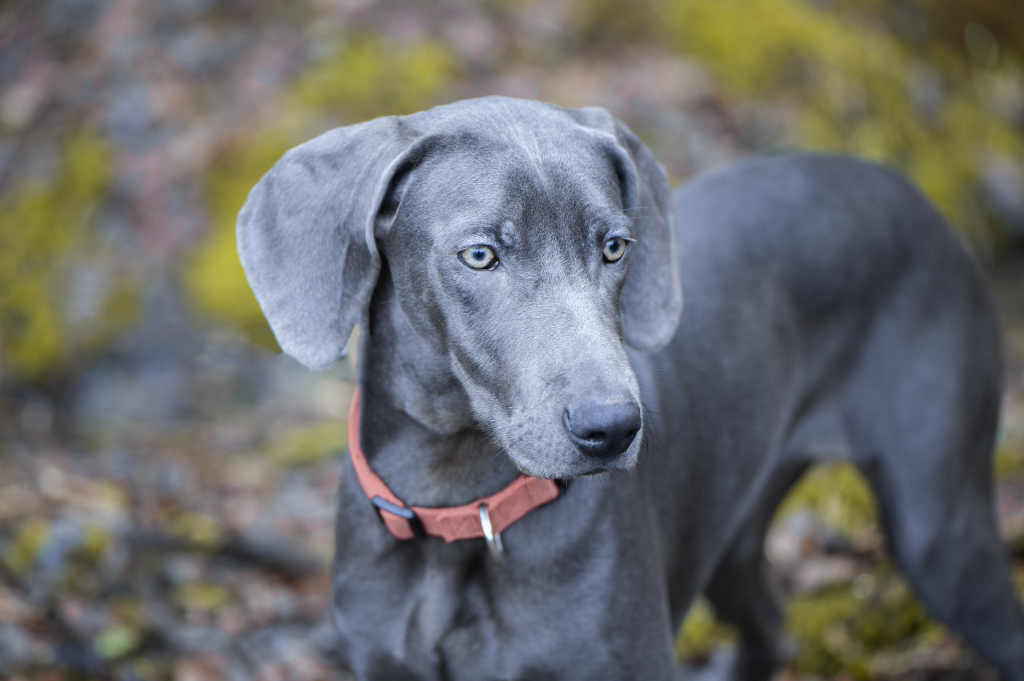Thinking of bringing a Weimaraner into the family? If so, this article is for you! We will explore everything you need to know about this dog breed, from its size and personality to how to care for it.
The Weimaraner is a medium-sized dog breed originally bred as a gundog in Germany. They sometimes are referred to as the Gray Ghost, Grey Ghost, or Silver Ghost. And the reason they got those nicknames is because of their distinctive gray coat and their stealthy hunting style.
Strong, fast, agile, and have a strong prey drive, the Weimaraner is an excellent hunter and can take down prey much larger than itself. In fact, they were used by royalty to hunt deer, wild boar, and even bears in the early days. However, as large game hunting has become less popular, Weimaraner’s hunting skills have transitioned more towards bird hunting and hunting small game like rabbits and foxes.
Today, the Weimaraner is still used as a hunting dog to scent, track, flush, point, and retrieve games thanks to its exceptional hunting abilities and versatility and is, without a doubt, one of the best all-around hunting dogs.
This breed is also becoming increasingly popular as a companion pet in the United States and all over the world, ranking within the top 50 most popular dog breeds thanks to its gentle and friendly temperament.
Weimaraners are good with children, friendly, loyal, and affectionate. However, they are highly active dogs and need plenty of exercise. They are born to run and love cross-country running, long-distance running, whether it be a 5K or 10K race, and with consistent training and patience, they can even run a marathon! So if you are an outdoor person, have the time and energy, and are certain that you can provide them with the exercise they need, they could be a perfect addition to your family.
Think you can keep up with them and want to bring one home? Then, read on to learn more about this gorgeous breed, including their history, appearance, living needs, how they behave, and how to care for them!
| An Overview of Weimaraner Breed Characteristics | |
|---|---|
| Weight | 55 - 90 pounds |
| Height | 23 - 27 inches |
| Life Expectancy | 10 - 13 years |
| Coat Type | Short, smooth with no undercoat |
| Colors | Gray, Silver-Gray, Blue |
| Breed Size | Medium-sized dogs |
| Breed Group | Sporting |
| Bred For | Hunting |
| Affectionate With Family | 5.0 out of 5.0 stars5.0 |
| Good With Children | 4.0 out of 5.0 stars4.0 |
| Good With Other Dogs | 3.0 out of 5.0 stars3.0 |
| Friendly Towards Strangers | 3.0 out of 5.0 stars3.0 |
| Breed Health | 3.0 out of 5.0 stars3.0 |
| Shedding Amount | 3.0 out of 5.0 stars3.0 |
| Grooming Needs | 2.0 out of 5.0 stars2.0 |
| Adaptability | 4.0 out of 5.0 stars4.0 |
| Trainability | 5.0 out of 5.0 stars5.0 |
| Prey Drive | 5.0 out of 5.0 stars5.0 |
| Playfulness | 5.0 out of 5.0 stars5.0 |
| Protective Nature | 5.0 out of 5.0 stars5.0 |
| Energy Level | 5.0 out of 5.0 stars5.0 |
| Apartment Living | 1.0 out of 5.0 stars1.0 |
| Good for First-Time Dog Owners | 2.0 out of 5.0 stars2.0 |
| Tolerate Being Left Alone | 1.0 out of 5.0 stars1.0 |
| Cold Tolerance | 2.0 out of 5.0 stars2.0 |
| Hot Tolerance | 4.0 out of 5.0 stars4.0 |
| Tendency to Drool | 3.0 out of 5.0 stars3.0 |
| Tendency to Bark | 3.0 out of 5.0 stars3.0 |
| Tendency to Snore | 3.0 out of 5.0 stars3.0 |
| Tendency to Dig | 3.0 out of 5.0 stars3.0 |
| Exercise Needs | 5.0 out of 5.0 stars5.0 |
| Mental Stimulation Needs | 5.0 out of 5.0 stars5.0 |
| Puppy Costs | 3.0 out of 5.0 stars3.0 |
Breed History & Origin

Arts and paintings dating back to the 14th century suggest that the Weimaraners’ ancestors were already around during that time, which they appear in the portrait of Charles V.
However, the breed we know today didn’t develop until the late 19th century when a German noble, Grand Duke Karl August, who held the court of Weimar, wanted to create a perfect gundog. A dog with exceptional speed, endurance, courage, intelligence, and tracking and scenting ability to hunt big game such as deer, wolves, mountain lions, and bears. And so, he began to crossbreed Bloodhounds with various German and French sporting dogs until he finally got his dream dog, the Weimar Pointer, or Weimaraner.
While the “Grand Duke Charles August of Weimar Theory” is more commonly held, some believe that the Weims descended from the now-extinct Chiens-Gris (gray dogs) brought to France by King Louis IX during the 13th century, and it’s called the “Gray Dogs of King Louis Theory.”
There’s even a third theory that claims the Weimaraner is actually a gray version of the German Shorthaired Pointer (GSP). This accidental outcome of gray coloration ironically became the breed’s hallmark, and the breed was then known as Weimar Setter. Or it could also be that Weimaraners were created by mixing heavy, old-style German dogs with English Pointers.
No one really knows for sure what Weimaraner’s exact history is, and the breed’s true origins remain a mystery to this day. However, regardless of its true ancestry, one thing for sure is that the German aristocracy formed the German Weimaraner Club, which strictly controlled the breed’s availability to the public, and the club was responsible for developing and refining Weimaraners.
In 1928, Howard Knight, a New England sportsman, joined the German Weimaraner Club, but he was only sent neutered dogs despite his promises to protect the breed’s bloodline and purity. Fortunately, his determination eventually paid off in 1938, and he was finally given several Weimaraners to breed, which he then brought to the United States.
With others’ and Knight’s efforts, the Weimaraner Club of America was formed in 1942, and the breed was granted official recognition by the American Kennel Club (AKC) in 1943.
The breed’s popularity began to rise in the 1950s when President Dwight Eisenhower owned a Weimaraner named Heidi and when Princess Grace Kelly received a Weimaraner from her brother as a wedding gift. Its popularity has gotten another boost after a photographer named William Wegman featured his Weimaraner in a series of photographs in which his dog wears human clothing!
Size & Appearance
Although the AKC considers Weimaraners a medium-sized breed, some Weims can grow quite big and may look like large-sized dogs. Male Weimaraners stand between 25 and 27 inches tall and can weigh anywhere from 70 to 90 pounds, whereas female dogs stand between 23 and 25 inches at the shoulders and are slightly lighter than males, weighing from 55 to 75 pounds.
Athletic, working dogs, Weimaraners have a muscular build, and their overall appearance can be summed up as regal, aristocratic, and graceful. The AKC describes them as “a picture of grace, speed, stamina, alertness, and balance,” with a strong, powerful body structure that demonstrates the ability to work fleetly.
As per the AKC’s breed standard, Weimaraners have a moderately long head, moderate stop, and a slight line extending back over their forehead, with long, slightly folded ears positioned high on their head and sitting a bit past their jaws.
Weimaraners’ eyes are set well apart, giving them a kind and intelligent look. Their eyes come in shades of gray, blue-gray, or light amber and will appear almost black when they are excited. They have a gray nose, but you may also find some Weimaraners come with a pink nose. However, those are considered minor faults by the AKC. Their lips and gums are always pinkish.
Weims have a clean-cut and moderately long neck, muscular body, well-developed chest, and deep, laid-back shoulders. Their backs should be moderate in length, straight, and sloped slightly from the withers, with a docked tail, measuring roughly 6 inches at maturity. Non-docked tail is considered a major fault by the AKC and will be penalized.
They have straight and strong forelegs, well-angulated stifles (knees), straight hocks (ankles), and firm, compact, webbed feet. Their nails can be gray or amber, and dewclaws should be removed. The way they run should look effortless and display smooth coordination.
Color, Coats, & Markings

Weimaraners have a short, sleek, smooth, and solid-colored coat, which their coat color can be in shades of silver-gray to mouse-gray and blends to lighter colors on their head and ears, hence their nickname. People don’t call them Gray Ghost for no reason!
Some Weims come in blue or black, but they are considered disqualified according to the breed standard. The AKC also disqualifies those with a distinctly long coat. White spots are allowed on the chest but will be penalized if found on any other body parts.
Weimaraners don’t have an undercoat, which will be easy when it comes to grooming. However, they do shed and aren’t hypoallergenic.
Temperament
Weimaraners are a friendly, intelligent, loyal, and affectionate breed that makes great family dogs. They are eager to please their owners and thrive on being around people. In fact, you will often hear Weims owners say that their Weimaraners can’t seem to get enough hugs, snuggles, and love and will always seek attention.
And as you may have guessed, Weims are highly active dogs and need plenty of exercises. They enjoy running, hunting, boating, hiking, and basically anything that gets them outdoors and keeps their minds occupied. And if not given enough physical and mental stimulation, they can become restless and will find ways to release their energy, such as chewing on furniture. Because of this, they are better suited for homes with yards and those who are active and can spend a good amount of time outdoors with their dog.
Since they are a hunting breed, Weimaraners have a high prey drive and will chase small animals such as squirrels, birds, rabbits, reptiles, cats, and small dogs. They will also chase joggers, bicyclists, cars, and basically anything that moves. However, providing them with proper socialization at an early age will help them get along with other people, dogs, and cats.
Weims are also very protective of their loved ones. They will bark to alert their owners if there is someone strange approaching or when something seems out of the ordinary, making them great watchdogs, though they are not considered an aggressive breed.
Weims are generally good with kids and make great playmates, but they may get too rough or boisterous when excited, and because of their size and energy level, they may unintentionally knock a child over. So make sure to keep an eye on your Weim when they are around kids.
Living Needs
Because Weimaraners are a highly active, working dog breed, they are best suited for people who have an equally active lifestyle and are not the best choice for people who live in an apartment or a smaller home where there’s no room for them to run around. They are also not suited to live in a kennel.
They thrive on spending time with their family and human interactions and do not tolerate being left alone for long periods. But if you have to leave them alone, make sure to provide them with plenty of toys and chewies to keep them occupied, or else they will find ways to entertain themselves (not the way you had in mind!)
Weimaraners prefer warmer weather and don’t do well during the winter months since they don’t have an undercoat to protect them from the cold. So, make sure to dress them up with a warm jacket or sweater during those colder days, and it’s also a good idea to provide them with a heated bed or blanket to keep them warm at night.
Exercise Needs
Weimaraners require a minimum of one and a half hours of vigorous exercise per day, preferably two. That means you need to go on multiple walks, runs, or hikes with them every day or engage in any other activity that gets their heart pumping, and hence you see they are often the top choice for avid runners.
Allowing them to play, run, and explore off-leash is also crucial to their well-being. So if you have a large backyard, consider building a dog run or setting up an agility course for your Weim to help burn off any of their excess energy!
Weimaraners also enjoy other activities such as playing fetch at the dog park, getting a good game of tug-of-war, or swimming. They also need plenty of mental stimulation to stay happy and content. So when you are not playing with them, make sure to provide them with interactive toys, such as puzzles and food dispensing toys, to keep their minds occupied.
Training

Weimaraners are intelligent dogs, coming in at #21 in the smartest dog breeds ranking. Plus, they are eager to please their owners, making them highly trainable. However, because they are also independent thinkers, they will constantly test your boundaries. So it’s crucial to be firm and consistent with your training and establish yourself as the alpha leader early on.
The best way to train your Weim is by using positive reinforcement methods such as rewards-based training. This means rewarding your canine for good behavior with treats, praise, and pets. Avoid using aversive training techniques such as punishment, scolding, or yelling, as this will only make your dog fearful and less likely to respond to you.
Start training your Weimaraner as soon as you bring them home, and we recommend you enroll your fido in a puppy kindergarten class to help them learn how to interact with other dogs properly. This is vital since Weimaraners have a high prey drive, and you don’t want them to chase or hurt other dogs in public when they grow up.
Health
Weims have an average lifespan of 10 to 13 years, and like all dogs, they are susceptible to some health conditions. These include:
- Distichiasis. This is a condition where the eyelashes grow out of the eye glands, causing eye irritation. This usually occurs in dogs under three years of age, and some of the signs include squinting, increased blinking, redness of the eye, and excessive tearing. If left untreated, it may lead to an open sore on the cornea’s outer layer and secondary bacterial infections.
- Entropion. This is also an eye condition where the eyelids roll inwards, causing the eyelashes to rub against the eye and causing irritation. If your Weimaraner has this condition, you’ll notice them keep pawing at their eyes, and the signs typically appear before their first birthday. Entropion can be corrected surgically, in which a section of the skin is removed to reverse its inward rolling.
- Gastric Dilatation-Volvulus (GDV). Also known as gastric torsion or bloat, it is a life-threatening condition that requires immediate veterinary attention. It usually occurs when the dog eats or drinks too fast, too much, or exercises too soon after the meal, causing the stomach to fill with gas and twist on itself and cutting off the blood supply to the heart. GDV is more common in deep-chested dogs like the Weimaraner, German Shepherd, Great Dane, etc., and can occur at any age. So it’s vital to be aware of the warning signs, which include retching (attempting to vomit but nothing comes out), excessive drooling, distended belly, and restlessness. Although scary, you can prevent this condition by feeding your Weimaraner smaller meals throughout the day instead of one large meal and avoiding vigorous exercise for an hour or two after eating.
- Hyperuricosuria. This is a condition where there is an increased uric acid level in the urine, leading to the formation of painful stones in the bladder or kidneys. Although it can be found in other breeds, it’s relatively common in Dalmatians, Bulldogs, and Black Russian Terriers. Weimaraners are also at a high risk of developing this condition. Some of the best ways to prevent it are to feed your dog a low-purine diet and increase your fido’s water intake. Also, note that hyperuricosuria is an autosomal recessive disorder, meaning the puppies need to receive two copies of the mutated genes from the parents to develop the condition.
- Hypothyroidism. This is a condition where the dog’s thyroid gland doesn’t produce enough of the hormone responsible for regulating the body’s metabolism, leading to weight gain, hair thinning, dry coat, lethargy, etc. If left untreated, it may cause vision loss and nerve disorders and potentially shorten your dog’s lifespan. Ways to prevent this include using a front-clip harness to avoid putting pressure on your Weimaraner’s neck, feeding them a balanced diet, and avoiding using household products that contain harmful chemicals.
- Hip Dysplasia. A common orthopedic condition in dogs, hip dysplasia, is when the ball and socket joint of the hip don’t fit together properly, causing the bones to rub against each other and resulting in pain, lameness, and arthritis. This condition can develop due to genetics, rapid growth rate, improper diet, and over-exercising during the puppyhood stages and is more common in large breeds like the Weimaraner, German Shepherd, Golden Retriever, etc. But there are things you can do to help minimize the risk. For instance, feed your Weimaraner a balanced diet, avoid excessive exercise during their growing years, and get your Weimaraner pup from a reputable breeder who has OFA or PennHip certification.
- Von Willebrand’s Disease (vWD). Unfortunately, Weimaraners are prone to this hereditary blood disorder that prevents their blood from clotting properly. This is caused by a deficiency in a protein responsible for platelet adhesion called the von Willebrand factor (vWF). The severity of vWD can range from mild to life-threatening, and there is no cure for it. And make sure to consult with your veterinarian if you think your Weimaraner has this condition to find the best way to manage it, as some drugs may interfere with the platelet function.
- Wobbler Syndrome. Also known as cervical spondylomyelopathy, wobbler syndrome is a neck disease in which the dog will experience compression of the spinal nerve roots and the spinal cord, resulting in neck pain and abnormal function of a body area. Dogs with Wobbler syndrome are easy to spot as they usually have a “wobbly” gait, mainly the rear limbs, and they may also walk with their head down. This can be treated with either surgical or non-surgical treatment options, which the latter is by using medications and restricting your Weimaraner’s exercise.
There’s no doubt that the Weimaraner dog breed is prone to several health conditions. However, some diseases are hereditary, while some can be prevented with proper care, a healthy diet, and appropriate exercise. So, don’t let that discourage you from getting one.
When purchasing a Weimaraner puppy from a breeder, ask for health clearances for the breeding dogs to prove that they have been tested for and cleared of a particular condition. And the Weimaraner Club of America (WCA) recommends breeding dogs have their hips, cardiac, thyroid, and eyes evaluated and DNA tested for Hyperuricosuria, Hypomyelination, and Spinal Dysraphisim.
It’s also crucial to take your pup to the vet for regular check-ups and keep up with their vaccinations and routine wellness visits so that if any health issues are detected, they can be treated early on before it becomes a more serious problem.
Feeding
You probably have read a lot about what to feed your Weimaraner. So, should you be feeding your Weim a dry, canned, raw, or cooked diet? Unfortunately, there is no definitive answer to this question. It varies depending on what your pup is allergic to, their age, activity level, and weight. So, always consult with your veterinarian to get more specific recommendations on what type of food to give your canine, as every dog is different.
How about the number of times to feed your Weimaraner each day? As a good rule of thumb, for Weimaraner puppies, you want to feed them three times a day, and you want to continue to do so until they are at least six months of age. Remember, Weimaraners are especially susceptible to Gastric Dilatation-Volvulus (GDV) or bloat. So it is crucial to split up their daily intake into smaller meals when they are still a puppy and stick to that feeding schedule. This can ensure that your pup gets off to a good start.
As for adult Weimaraners, you can switch their mealtimes to twice a day, and remember to avoid exercising them too soon after eating. Also, it’s a good idea to get one of those special bowls to slow down their eating, which is another way to keep bloat at bay.
When it comes to the portion size, a two months old Weimaraner puppy will typically need 1/2 to 3/4 cups of food per day, split into three meals. But from there onwards, I can’t give you the exact amount as it depends on your puppy’s weight, and you will have to read the feeding instructions on the food packaging. Once they reach adulthood, most Weimaraners may need up to 4 cups of food per day, divided into two meals.
There are various brands and formulas to choose from. But you always want to go for a high-quality kibble that is nutritious and has the right amount of protein, calories, fats, vitamins, and minerals your Weimaraner needs. Avoid ones that contain butylated hydroxyanisole (BHA), butylated hydroxytoluene (BHT), and artificial ingredients. Also, many Weimaraners don’t tolerate grains well, corn and wheat in particular. So try to avoid those as well when buying food for your fido.
Grooming & Bathing
Fortunately for Weimaraner lovers, Weims are not a high-maintenance dog breed, as their coat is short, plus they don’t have an undercoat. So brushing them once a week will usually be enough to remove excess or dead hair and keep their coat looking clean. They also don’t need to be bathed too often, only when necessary, meaning when they are visibly dirty or start to smell.
Like all dogs with floppy ears, Weimaraners are prone to ear infections due to the fact that their long, hanging ears can easily trap moisture, dirt, and debris. Their ears are also a common place where parasites like ticks, fleas, and mites like to hide and can prove to be a problem. So, make sure to clean their ears thoroughly with a dog ear-cleaning solution at least once a week.
Don’t forget those nails! Their nails should be trimmed regularly, typically every two to four weeks, as overgrown nails can make it painful for your canine to walk. You can easily do it yourself with a nail clipper for dogs, though I prefer using a nail grinder because it’s less stressful for your canine, plus it gives you more control.
As for the teeth, just like us humans, Weimaraners need to have their chompers brushed daily to prevent dental problems such as gum disease from developing. In fact, vets recommend brushing their teeth at least once or twice a day. But if you don’t have time for that, once every two days will do, and that’s usually enough to prevent plaque and tartar buildup.
You May Also Like: Best Dry Shampoo for Dogs
What to Expect When Owning a Weimaraner - A Brief Summary

Well. As you already know, Weimaraners are high-energy dogs that need a good deal of exercise, at least an hour and a half to two per day. So if you’re not an active person, they might not be the right breed for you. Also, they may not be suitable for those who live in an apartment, as they need plenty of space to run and play.
Additionally, they are not the best choice for first-time dog owners as they need someone who’s firm, confident, and consistent when it comes to training and handling them.
But all in all, Weimaraners are wonderful dogs that make great companions for the right owner. They are a loyal and loving companion who will always be by your side. They are also intelligent and eager to please, so they are generally easy to train. Plus, grooming them isn’t a difficult task.
So, if you have an active lifestyle or love hunting and think you can provide them with what they need, then go ahead and add one of these beautiful pups to your family!
Buying a Weimaraner From a Breeder
Think the Weimaraner is the right breed for you and want to buy one from a breeder? Be sure to do your research first, as there are many unscrupulous breeders out there who only care about making a quick buck.
A good, responsible breeder will be able to provide you with all the necessary paperwork, such as the dog’s pedigree, health and vaccination certificates, registration certificate, contract, etc. They will also be able to answer any questions you may have about your new pup and provide you with all the information you need to know about the breed. Plus, they will allow you to meet your future pup before bringing them home.
The AKC has a list of breeders that you can contact, and that’s always a good place to start if you’re not sure where to look. Or you can always ask your vet or on dog forums to see if they know any good breeder. As for the price of Weimaraner puppies, they can cost anywhere from $800 to $1,500, and you can expect to pay up to 3,000 or more if they are show quality.
Adopting a Weimaraner From a Rescue or Shelter
If you’re not interested in buying a Weimaraner puppy from a breeder or have a tight budget, why not consider adopting one from a rescue or shelter? There are many wonderful Weimaraners out there waiting for their forever home, and they would love nothing more than to have you as their new owner.
Adopting an adult Weimaraner also means you won’t have to deal with all the energy and mischief that comes with raising a puppy. Plus, adoption fees are much lower than if you were to buy a puppy from a breeder, which will typically cost between $100 and $650 only.
One thing, though, when adopting one, be sure to ask about their temperament, if they have any health issues, and any other important things that you need to know about the dog, like why did the dog ends up there and whatnot. You want to ask as many questions as you can to learn as much as possible about your potential new pup so that there are no surprises when you bring them home.
Fun Facts About Weimaraners That You Probably Don't Know
- Weimaraners have exceptional scenting ability and are often used for search and rescue missions. In fact, a popular Weim named Dingo, who was used to sniff out missile parts during the Cold War, is one of the best tracking dogs at White Sands Missile Range.
- Weimaraners were originally bred for hunting big game such as bears, wild boar, deer, but these days they are used for hunting smaller game such as quail, pheasants, hares, foxes, and martens.
- Weimaraners are known for being loyal, affectionate, and devoted to their families. They love nothing more than being close to their humans and are often called “velcro dogs.”
- The name “Weimaraner” comes from the German city of Weimar, where the breed was developed.
- Weimaraners got the nickname “gray ghost” because of their gray coats and catlike hunting style.
- Weimaraners are often compared to Vizslas because they have a similar build and appearance.
- Princess Grace Kelly and President Eisenhower owned a Weimaraner.
- Many Americans’ exposure to Weimaraners was through the artwork of William Wegman.
- Weimaraner puppies are born with stripes but will fade a few days later.

